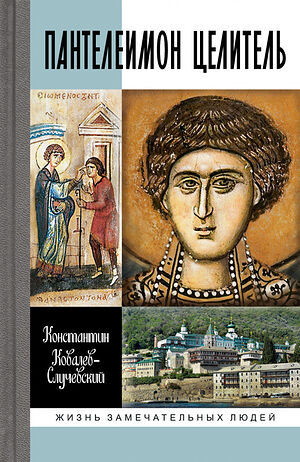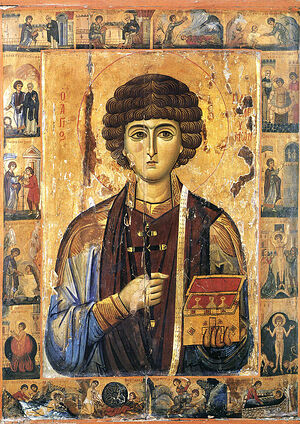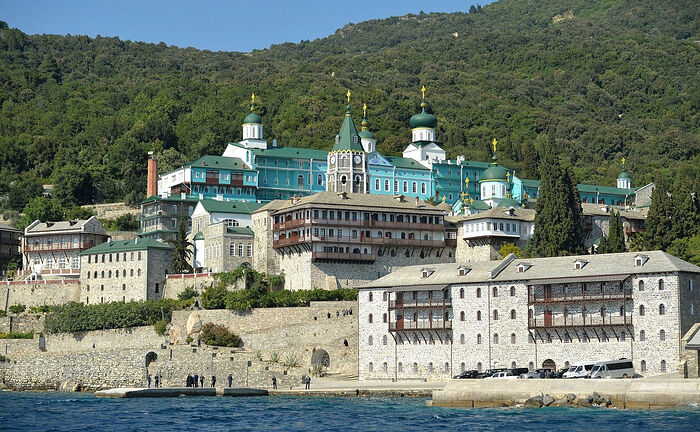August 9 is the feast of the Great-Martyr and Healer Panteleimon, one of the most venerated Christian saints. He is quick to help when someone is ill, in an emergency, or on the brink of death. This unmercenary physician is the embodiment of mercy and love. Writer Konstantin Kovalev-Sluchevsky, author of the book, Panteleimon the Healer, recently published in Russian, talks about the saint’s life and service.
 —Konstantin Petrovich, there are many stories about miraculous help from St. Panteleimon the Healer. Can you share one of them?
—Konstantin Petrovich, there are many stories about miraculous help from St. Panteleimon the Healer. Can you share one of them?
—It happened not long ago: My friends’ small child fell seriously ill. The doctors did not understand what was going on—the baby was doing very poorly and fading away, and nobody could make an accurate diagnosis. Someone close to them advised them to seek help from St. Panteleimon the Healer. My friends are modern, successful people and not prone to emotional excitement. But someone gave them some oil from the lamp in front of St. Pantelemon’s icon, and they began to anoint the child with it. And a miracle occurred: Within a short time—in a week—the child went on the mend. This is a real story.
Moreover there was an amazing coincidence: Still unaware of what had happened, I gave this family my newly published book about St. Panteleimon. My friends were very surprised by these events and took the occurrence very seriously.
By the way, a similar example is known in recent history, connected with the holy New Martyr Grand Duchess Elizabeth Feodorovna. A sister named Stefanida fell ill at the Sts. Martha and Mary’s Convent of Mercy, which St. Elizabeth had founded. She needed a neurosurgical operation—trepanation of the skull. It was the verdict of the best neurosurgeons at the request of the wife of the Governor-General of Moscow. The day before the supposed operation the Grand Duchess sent Stefanida to the Moscow Chapel of St. Panteleimon near Kitai-Gorod. There an Athonite elder anointed the sister’s head with oil from the lamp in front of the Athonite icon of Great-Martyr Panteleimon. The next day the operation was postponed and then cancelled. The sister was healthy.
—St. Panteleimon the Healer is one of the most popular saints in Christendom. How can this fact be explained?
—Even before writing the book, I was surprised; you can enter any Orthodox church and you are sure to see an icon of St. Panteleimon in it—if not in the middle, then surely somewhere in a corner. He is as popular as Sts. Nicholas the Wonderworker or Sergius of Radonezh here. What is the explanation for this? Why such attention to him? The answer lies on the surface—health-related problems concern everyone. All of us have a medicine chest at home; people often talk about illness, medicine, old age, and aging. Some take plenty of pills around the clock. Life has a time limit. What is more important for us—to get into a better shape, to get patched up, or to be completely healed? Many people constantly go to doctors and at the same time cannot cope with their illnesses, because health issues are very often linked with our spiritual state.
—How should a Christian perceive illness?
—Over the centuries Christian ascetics have repeated that the source of all illnesses and ailments came about as a result of the “epidemic” of evil that started from the fall of Adam and Eve. After this catastrophe man became mortal and susceptible to sickness. Christians understand that sin is at the root of all diseases. And for a cure it is not enough to take medications. Spiritual work is also vital, as the spiritual elders say—prayer, fasting, and repentance. We must look for the source of the sickness, its root. Then healing is possible, and not just a temporary victory over the ailment. We know that many saints healed the sick and even raised people from the dead, as it is written in the Gospel of Matthew:
Heal the sick, cleanse the lepers, raise the dead, cast out devils: freely ye have received, freely give (Mt. 10:8).
This amazing phrase means that the main Physician in our history and in our universe is Jesus Christ Himself. The words, freely ye have received, freely give, are directly related to Panteleimon the Healer. He never charged for treatment, he was an unmercenary physician.
—Does altruism demonstrate the purity of the soul and love for people?
—A doctor who treats patients for money is interested in them visiting him as long as possible and paying him money. But a disinterested physician is interested in a patient’s recovery as quickly as possible. Since ancient times there has been the Hippocratic oath: medics promise that they will not harm their patients, but will fulfill their professional responsibilities conscientiously. And what is more important—the oath or the commandment of love for your neighbor, which is given in the Gospel? In the Holy Scriptures you can find the phrase: Swear not at all (Mt. 5:34)! We know how easy it can be to break an oath. The Apostle Peter vowed that he would follow Christ, but in a moment of weakness he was overcome by fear and broke his promise. An oath helps to treat, but love heals. By fulfilling the commandment of love for your neighbor you can overcome an illness.
Healer Panteleimon was a very young man when he studied medicine in the late third and early fourth centuries AD. He was the physician of Emperor Maximian (Galerius) and enjoyed his confidence. His special position caused envy and hatred on the part of a whole staff of court physicians who treated the emperor for money. Many people wanted to have St. Panteleimon removed. And so he was slandered and accused of witchcraft, which, of course, was absolutely unthinkable for Christians. And then St. Panteleimon fell victim to the persecution of Christians, and suffered a martyr’s death. Presumably, he was only twenty-nine years old.
—Did Christianity contribute to the development of medicine?
—Christians began to set up hospitals where they received sick people and treated them, particularly during epidemics. Since believers in Christ supported each other, they were more likely to survive during trials. During the pandemic of the mid-third century in the pagan Roman Empire, half of the population died. With Christianity a new understanding of mercy and charity appeared: they began to be perceived not as an obligation (as was the case in antiquity), but were filled with true sympathy, compassion, and love. All this gradually transformed the pagan Roman Empire into the Christian Byzantine Empire. St. Panteleimon lived in those transitional times.
—St. Panteleimon the Healer did not neglect scientific knowledge, did he?
—He was a highly educated physician, with the entire body of ancient medical knowledge at his disposal. Many remedies were kept secret by doctors in ancient Rome, and they made money on it. Even today we see that doctors do not like to share their knowledge, and they do not always explain to patients what is wrong with them and how exactly they will be treated. Sometimes they just prescribe medicine and then say, “The appointment is over.” As a saying goes, today if you are drowning, it’s sink or swim. St. Panteleimon the Healer was an ideal physician and a model of altruism. He stands on a par with the Apostle Luke, who was a physician as well; and with the Unmercenary Physicians Cosmas and Damian and St. Luke (Voino-Yasenetsky).
 The Great-Martyr and Healer Panteleimon. An icon with Life scenes. St. Catherine’s Monastery on Mt. Sinai (Egypt). Thirteenth century. —What can you tell us about the iconography of St. Panteleimon the Healer and his images in painting?
The Great-Martyr and Healer Panteleimon. An icon with Life scenes. St. Catherine’s Monastery on Mt. Sinai (Egypt). Thirteenth century. —What can you tell us about the iconography of St. Panteleimon the Healer and his images in painting?
—On icons he is depicted as a young man with a shock of thick curly hair. He holds a Communion spoon, a vessel or a medicine box in his hands. One of the most famous icons is an icon with his Life scenes. It was painted in the thirteenth century and is now situated at St. Catherine’s Monastery on Mt. Sinai, Egypt. The great saint’s Christian path began with a miracle. As a young physician Pantaleon (this name means “a lion in everything”) was walking down the street and saw a child lying dead after being bitten by a poisonous snake. He turned to God in despair so that Christ would raise the child from the dead. And at the same moment the child rose up alive. This dazzled the young physician so much that he was spiritually transformed, baptized and received the new name Panteleimon, which means “all-merciful”.
There is the Church of St. Panteleimon (“San Pantalon”) in Venice. A huge painting by the artist Paolo Veronese (1528–1588), depicting the transfiguration of St. Panteleimon, hangs there. There are also stunning enormous ceiling paintings dedicated to St. Panteleimon and his path of martyrdom at the same church. The veneration of this unmercenary healer is widespread in Italy, France, Germany, Spain, and Portugal.
 Russian St. Panteleimon Monastery on Mt. Athos. A modern photo
Russian St. Panteleimon Monastery on Mt. Athos. A modern photo
—How did the veneration of this Christian saint come to our country?
—The veneration of St. Panteleimon the Healer has been known in Russia since the late eleventh century. It gradually spread from the Byzantine Empire and Western Europe: his icons and frescoes appeared in churches and monasteries. For example, there is a large fresco depicting St. Panteleimon and an icon with a reliquary brought from Mt. Athos at the entrance to the Cathedral of the Nativity of the Theotokos of the Monastery of St. Savva of Storozhev in Zvenigorod near Moscow.
In 1862, Hieromonk Arseny (Minin) came to Russia from the Russian St. Panteleimon Monastery on Mt. Athos with a particle of the relics of the great-martyr, and he traveled to many cities of our country. Then cross processions were held with numerous healings. After that, widespread veneration of the saint began. In Moscow a huge four-storied Chapel of St. Panteleimon the Healer was built at the intersection of Nikolskaya Street and Lubyanka Square. This chapel housed a wonderworking icon, which was left by an Athonite monk. Unfortunately, in 1934 the chapel was destroyed. But the icon, thank God, was saved. Today it is kept at the Church of the Resurrection of Christ in Sokolniki.
—How has the veneration of St. Panteleimon the Healer influenced Russian culture?
—In 1866 the poet Alexei Konstantinovich Tolstoy (1817–1875) wrote a poem entitled Pantelei the Healer.
O Lord Pantelei
Have pity on us
And pour your wonderful oil
On our wounds.
Sergei Rachmaninov composed a piece of choral music based on this text. It is almost never performed. The Moscow Synodal Choir soon intends to revive this tradition.
The writer Anton Chekhov (1860–1904) had a small icon of St. Panteleimon in a silver frame; this relic was given to him by his father.
The poet Nikolai Gumilev (1886–1921) wrote his poem, A Vision, during the First World War, in which Sts. Panteleimon the Healer and George the Victorious come to the protagonist, who “was lying in bed, sick and exhausted.” They heal and encourage him. The poet puts the following words in the mouth of Panteleimon the Healer:
Your reddened eyes are sleepless,
The head of your bed is burning and suffocating,
But I will touch you with the edge of my garments
And pour golden health into your veins…
The writer Boris Zaitsev (1881–1972) wrote a book of travel essays about visiting Mt. Athos. In particular, he writes in it about Russian people’s the special veneration for the holy physician, noting that the Russian nation, with all its “Karamazovism”,1 “needs St. Panteleimon’s healing spoon more than anyone else.”
—You wrote your book about the holy physician during the COVID-19 epidemic. Is there any symbolic meaning here?
—My book, Panteleimon the Healer, has a subtitle: Healing of the Soul and a Pandemic of Good. By giving it this title, I tried to make a reference to the epidemic of COVID-19 that has been around for several years. The pandemic is not over yet, and many global shocks and various social restrictions are associated with it. Let me remind you that a similar epidemic turned the Roman Empire into the Byzantine Empire.
And today we are on the brink of new destructive disaster that pose a threat to our civilization’s survival. Something has changed in people’s minds during the pandemic. Modern people, accustomed to comfort, suddenly began to understand again how vulnerable they are in the face of dangerous diseases or injuries. And the person of St. Panteleimon becomes especially attractive in these circumstances. We all need healing of the soul and we can respond to any epidemic with a “pandemic of good”. Many believers can probably share their stories about how they received support from this Christian martyr. St. Panteleimon the Healer is quick to help, healing people from various diseases and ailments; he is the patron-saint of doctors and soldiers; he saves people from accidents and comforts the lonely. In Orthodoxy his name is invoked during the sacrament of unction, during the blessing of waters and in prayers for the sick.
